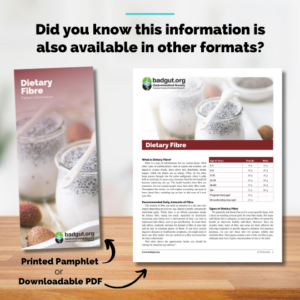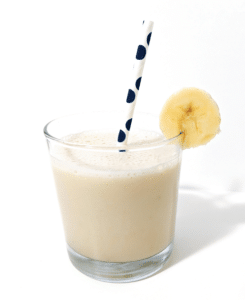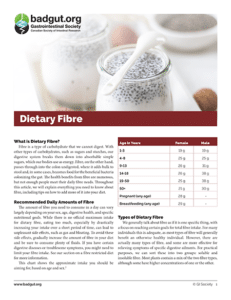Click here to download a PDF of this information.
Dietary Fibre
What you need to know to maintain a healthy gut
What is Dietary Fibre?

Benefits of Fibre
- improves gut microbiome1
- reduces digestive symptoms such as constipation and diarrhea2
- helps regulate blood sugar3
- lowers cholesterol levels4
- reduces risk of diverticular disease5
- reduces risk of colorectal cancer6
- increases satiety of meals, leading to better weight control7
Recommended Daily Amounts of Dietary Fibre
The amount of fibre you need to consume in a day can vary largely depending on your sex, age, digestive health, and specific nutritional goals. While there is no official maximum intake for dietary fibre, eating too much, especially by drastically increasing your intake over a short period of time, can lead to unpleasant side effects, such as gas and bloating. To avoid these side effects, gradually increase the amount of fibre in your diet and be sure to consume plenty of fluids. If you have certain digestive diseases or troublesome symptoms, you might need to limit your fibre intake. See our section on a fibre restricted diet for more information.
This chart shows the approximate intake you should be aiming for, based on age and sex.2
| Age in Years | Female | Male |
|---|---|---|
| 1-3 | 19 g | 19 g |
| 4-8 | 25 g | 25 g |
| 9-13 | 26 g | 31 g |
| 14-18 | 26 g | 38 g |
| 19-50 | 25 g | 38 g |
| 50+ | 21 g | 30 g |
| Pregnant (any age) | 28 g | – |
| Breastfeeding (any age) | 29 g | – |
Types of Dietary Fibre
We generally talk about fibre as if it is one specific thing, with a focus on reaching certain goals for total fibre intake. For many individuals this is adequate, as most types of fibre will generally benefit an otherwise healthy individual. However, there are actually many types of fibre, and some are more effective for relieving symptoms of specific digestive ailments. For practical purposes, we can sort these into two groups: soluble and insoluble fibre. Most plants contain a mix of the two fibre types, although some have higher concentrations of one or the other.
High-Fibre Foods
- whole grains (whole wheat products, oats, barley, popcorn, wild rice, etc.)
- legumes (beans, lentils, peas, edamame)
- nuts/seeds (chia seeds, flaxseed, pumpkin seeds, almonds, pistachios, walnuts, etc.)
- fruits (most varieties)
- vegetables (most varieties)
Soluble Fibre
These are fibres that are soluble in water. The primary types of soluble fibre include pectins (veggies, fruits), gums (gum Arabic), mucilages (guar, carrageenan), and some hemicelluloses. These fibres are especially beneficial for individuals with diarrhea, as they help slow down transit time. Soluble fibre also helps delay glucose absorption and lowers blood cholesterol. Sources include:
- fruits (especially apples and citrus)
- flaxseed
- oats
- barley
- legumes
- psyllium
Insoluble Fibre
Unlike soluble fibre, insoluble fibre does not dissolve in water. The main types of insoluble fibre include cellulose (primary material of plant cell walls), many hemicelluloses (cereal fibres), and lignins (non-polysaccharide). This is the best type of fibre for constipation, as it helps draw water into the stool to soften it and can help speed up transit time. It also increases fecal weight, which improves bowel movement consistency, and delays glucose absorption. Sources include:
- woody parts of vegetables
- small seeds (strawberries)
- wheat bran and corn bran
- whole grain breads and cereals
- vegetables (cabbage, carrots, Brussels sprouts)
- legumes
Resistant Starch
While not actually a type of fibre, resistant starches behave similarly to fibre in the gut. Like fibre, resistant starches do not break down into sugar and are not absorbed via the small intestine. While they are technically starches, they make it through the digestive system intact and ferment in the large intestine. They can help feed beneficial gut bacteria and improve the balance of the microbiome.8 Sources include:
- starchy foods coated with seeds or germ (unprocessed whole grains, legumes such as soybean seeds, beans, lentils, and dried peas)
- naturally resistant starchy foods (uncooked potatoes, green banana flour, and high-amylose corn flour)
- retrograded starch, which occurs in starchy food that has been cooked and then cooled (potatoes or pasta cooked and cooled for a salad, sushi rice, etc.)
- starchy foods that manufacturers chemically modify so that they are resistant to digestion
Fibre Superstars
If you want to give your fibre intake a boost, find room for some of these foods in your diet:
| Food Item | Fibre Content | Serving Size |
|---|---|---|
| bran (oat or wheat) | 10-12 g | 30 g |
| chia seeds | 10 g | 30 g |
| flaxseed | 8 g | 30 g |
| artichoke | 10 g | 1 medium (128 g) |
| beans and lentils | 6-9.5 g | ½ cup, cooked (85 g) |
| avocado | 7 g | ½ average (100 g) |
| raspberries | 8 g | 1 cup (120 g) |
Tips to Add More Fibre to Any Meal
- replace white starches with whole grain versions
- fill up half your plate with vegetables
- eat your veggie peels (if they are safe to eat), since most of the fibre is often found there
- try using avocado instead of mayonnaise or cheese on a sandwich
- sprinkle nuts or seeds on your salad
- try a vegetarian meal with beans or lentils instead of meat
- opt for whole fruits/vegetables instead of juice
- add fresh, frozen, or dried fruit to yogurt, cereal, and oatmeal
- snack on veggies dipped in hummus or guacamole, air-popped popcorn, and fresh fruit
Commercially-Prepared Fibre
Fibrous foods tend to be high in many other nutrients and are often inexpensive, which is why it is generally ideal to increase the amount of fibre in your diet by changing what you eat. However, you can also increase your fibre intake by taking commercial supplements. You might find it simpler to just add a supplement instead of overhauling your diet, or perhaps you are already eating a decent amount of fibrous foods, but need a little help to reach your fibre goal. Fibre supplements also take the guesswork out of gradually increasing your fibre intake, since you can easily adjust the amount you take.
Types & Common Brands
There are many types of commercial fibre supplements available, and the exact types you can find will vary on your location. Some common products include:
- psyllium (Metamucil®), soluble and insoluble fibre
- inulin (Benefibre®), soluble fibre
- methylcellulose (Citrucel®), soluble fibre
How to Start
As with fibre from food sources, it is important to increase the dose gradually and drink plenty of fluids. Follow the recommendations on the product label or instructions from your doctor or dietitian for more details on how to use a specific product.
The Importance of Water
When you are trying to increase the amount of fibre you consume, it is important to also monitor your water intake. If you eat more fibre but don’t drink more water, your stools can become too dry, causing or worsening constipation. Make sure to drink plenty of fluids to prevent this. If you have diarrhea, you might be tempted to drink less water to reduce the looseness of your stools. However, experiencing regular diarrhea puts you at risk of dehydration. If you are losing a lot of liquid through diarrhea, an electrolyte beverage might be more beneficial for you than plain water. See our Slow-it-Down Smoothie recipe below.
Does Fibre Help Digestive Illness?
Fibre is great for overall health, but is it really a viable treatment for those affected by GI illnesses? Here we review some of the areas where fibre is effective, as well as those where fibre just isn’t enough. Always remember to consult your healthcare team before changing your treatment plan.
Constipation & Hemorrhoids
Fibre is generally considered the first-line approach for treating constipation as well as hemorrhoids that result from constipation. For many who are constipated, consuming more insoluble fibre and plenty of water is enough to relieve symptoms. It’s the simplest, safest, and often most effective treatment for this common symptom. However, sometimes fibre is not adequate for individuals with chronic constipation or constipation-predominant irritable bowel syndrome, who might require a more intensive treatment plan.
Diarrhea
Whether or not fibre is effective for treating diarrhea often depends on the cause. If you have diarrhea from an infection with a bacteria or parasite, severe diarrhea-predominant irritable bowel syndrome, or you are experiencing a flare-up of Crohn’s disease or ulcerative colitis, it is unlikely that fibre will be enough to slow things down. However, if you have mild diarrhea-predominant irritable bowel syndrome, or experience occasional diarrhea without a known cause, increasing the amount of fibre, particularly soluble fibre, into your diet can often help reduce symptoms.
Irritable Bowel Syndrome (IBS)
IBS is a chronic, often debilitating, functional gastrointestinal disorder with symptoms that include abdominal pain, bloating, and altered bowel behaviours, such as constipation and/or diarrhea, or alternating between the two. Fibre can be very effective for many individuals with IBS. For constipation-predominant IBS, focus on eating more insoluble fibre. For diarrhea-predominant IBS, focus on soluble fibre and avoid consuming too much insoluble fibre (particularly bran) as this might increase diarrhea. If you have mixed-type IBS, try increasing your fibre intake in general. But a warning to those with IBS, it is extra important to be cautious and patient when increasing your fibre intake. Don’t make sudden drastic changes to your diet, and ensure you drink plenty of fluids, because your gut might be extra sensitive to a sudden increase in fibre. However, a high-fibre diet isn’t ideal for everyone with IBS. If your symptoms are mild to moderate, fibre can often be a great treatment. If your IBS is severe, fibre might make your symptoms worse. Speak with your healthcare team before making changes to your IBS treatment plan.
Inflammatory Bowel Disease (IBD)
Inflammatory bowel disease is a term that primarily refers to two diseases of the intestines: Crohn’s disease and ulcerative colitis. Both diseases involve inflammation in the digestive tract, although the location and extent of inflammation are different. IBD symptoms, which include diarrhea, abdominal pain, fever, anemia, and weight loss, can be severe and greatly affect quality of life. When individuals with IBD are doing well, eating enough fibre can help keep things working in the digestive system. Above and beyond the standard regulation of bowel movements, fibre might help those with IBD by encouraging favourable changes in the gut microbiota. Research shows that eating more fibre can help modify the balance of gut bacteria by increasing the beneficial strains and decreasing the harmful ones in some individuals with IBD.9 However, during a flare-up, those with IBD will likely need to go on a fibre-restricted diet to give their bowel time to heal.
Diverticular Disease
In diverticular disease, small sac-like out-pouchings of the colon lining (diverticula) bulge through the outer colon wall. Some studies show that individuals who eat diets higher in fibre are less likely to develop diverticular disease.4 However, if you have diverticular disease and experience a flare-up (diverticulitis), then you might also need to avoid fibre to give your bowel time to heal.
Fibre-Restricted Diets
While fibre is generally great for your digestive and overall health, there are some cases where you need to limit the amount of fibre in your diet. Your physician might recommend that you follow a fibre-restricted diet if you are having a flare-up of a digestive illness, such as Crohn’s disease, ulcerative colitis, diverticular disease, or irritable bowel syndrome, or if you are recovering from a surgery in the digestive tract. In these cases, a fibre-restricted diet can help lower the amount of work for the digestive system so that it can heal and reduce symptoms caused by high fecal volume passing over irritated or inflamed digestive tissues. To maintain a fibre-restricted diet, you will need to reduce the quantity of foods high in fibre in your diet and fill up on foods that are low in fibre.
Food That Has No Fibre/Very Little Fibre
As fibre is a plant-based carbohydrate, animal products, including meat, fish, eggs, and dairy, contain no fibre naturally. However, manufacturers might fortify certain products, such as some yogurts, with fibre. In addition, some heavily processed plant foods, such as white flour, are very low in fibre, and some, such as sugar and oil, contain no fibre at all. Foods low in fibre include:
- meat (beef, chicken, pork, lamb, etc.)
- fish and shellfish (salmon, tuna, shrimp, oysters, crab, etc.)
- eggs
- tofu
- dairy (milk, cheese, sour cream, yogurt, etc.)
- milk alternatives (soymilk, almond milk, rice milk, coconut milk, etc.)
- sweeteners (white and brown sugar, honey, syrups, artificial sweeteners, etc.)
- oils and fats (butter, ghee, lard, olive oil, canola oil, coconut oil, etc.)
- fruit and vegetable juice without pulp
- white bread, white pasta, white rice
- cereals and baked goods made with white flour
- liquid meal replacements (Ensure®, Boost®, etc.)
Tips for Fibre-Restricted Diets
- avoid fruit and vegetable peels, as these often contain high amounts of fibre
- make sure to cook vegetables well, as this makes them easier to tolerate
- choose canned fruits and vegetables over fresh
- eat white bread or white rice instead of the whole grain versions
- choose versions of foods that don’t have chunks (e.g., yogurt without fruit added, juice without pulp, jelly instead of jam, yellow mustard instead of Dijon, etc.)
- opt for meat, eggs, or tofu instead of beans for protein
- avoid other foods that can irritate the digestive system, such as spicy foods, alcohol, and caffeine (coffee and tea)
- you might also need to avoid dairy, if you are sensitive
- read food labels to find out the fibre content if you aren’t sure how much they contain
- contact a registered dietitian for tips on getting the nutrition you need while avoiding many foods
Recipes
Slow-It-Down Smoothie
 If diarrhea is a problem for you, this smoothie can help slow down your digestion and lead to bowel movements that are better formed. It is also a good source of potassium and magnesium, important nutrients that diarrhea can deplete.
If diarrhea is a problem for you, this smoothie can help slow down your digestion and lead to bowel movements that are better formed. It is also a good source of potassium and magnesium, important nutrients that diarrhea can deplete.
Ingredients
- 1 cup of water or milk (nut, oat, dairy, soy depending on your tolerance)
- 1 cup of frozen bananas
- Honey (or sweetener of choice) to taste
Method
- Blend all the ingredients in a high-speed blender until smooth.
- Serve immediately.
Get-it-Going Spread
 This spread is great on a whole wheat English muffin or scone as an alternative to jam. Use it sparingly at first, to see how your digestive tract reacts.
This spread is great on a whole wheat English muffin or scone as an alternative to jam. Use it sparingly at first, to see how your digestive tract reacts.
Ingredients
- ½ cup pitted prunes
- ½ cup raisins
- ½ cup pitted dates
- ¼ cup orange juice
- ⅓ cup prune juice
- ⅛ tsp cinnamon
- pinch of clove
Method
- blend all the ingredients in a food processor until smooth
- refrigerate up to 2 weeks or freeze for longer periods


